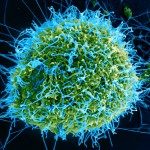Lien vers Pubmed [PMID] – 12551993
J. Virol. 2003 Feb;77(4):2550-8
The requirement of human immunodeficiency virus (HIV)-induced CCR5 activation for infection by R5 HIV type 1 (HIV-1) strains remains controversial. Ectopic CCR5 expression in CD4(+)-transformed cells or pharmacological inhibition of G(alpha)i proteins coupled to CCR5 left unsolved whether CCR5-dependent cell activation is necessary for the HIV life cycle. In this study, we investigated the role played by HIV-induced CCR5-dependent cell signaling during infection of primary CD4-expressing leukocytes. Using lentiviral vectors, we restored CCR5 expression in T lymphocytes and macrophages from individuals carrying the homozygous 32-bp deletion of the CCR5 gene (ccr5 Delta32/Delta32). Expression of wild-type (wt) CCR5 in ccr5 Delta32/Delta32 cells permitted infection by R5 HIV isolates. We assessed the capacity of a CCR5 derivative carrying a mutated DRY motif (CCR5-R126N) in the second intracellular loop to work as an HIV-1 coreceptor. The R126N mutation is known to disable G protein coupling and agonist-induced signal transduction through CCR5 and other G protein-coupled receptors. Despite its inability to promote either intracellular calcium mobilization or cell chemotaxis, the inactive CCR5-R126N mutant provided full coreceptor function to several R5 HIV-1 isolates in primary cells as efficiently as wt CCR5. We conclude that in a primary, CCR5-reconstituted CD4(+) cell environment, G protein signaling is dispensable for R5 HIV-1 isolates to actively infect primary CD4(+) T lymphocytes or macrophages.

